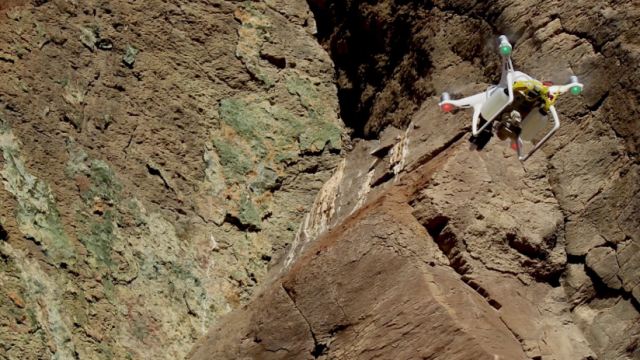Tim Shields spends a lot of time in the Mojave Desert. Sometimes, he camps out there for weeks at a time. As a desert biologist for nearly 40 years now, Shields doesn’t mind the extreme high and low temperatures that the California desert presents. He’d rather gaze at the desert night sky than a dull hotel room ceiling fan.
But he’s out there with a bigger purpose than staring at the sky. Shields’ is constantly searching for raven nests, often tucked in the branches of the Mojave’s signature Joshua tree. But the biologist isn’t exactly a raven expert. He’s a desert tortoise researcher. Unfortunately, ravens have become one of the threatened tortoise’s greatest threats. The jet black birds love to feast on baby tortoises whose shells are too soft to offer them much protection. Now, Shields is focused on how to reduce raven populations throughout the Mojave Desert to help tortoises reach reproductive age and, well, survive.
The key? Drones.
“I don’t hate ravens,” Shields told Gizmodo. “I don’t like the fact that there are so many of them.”
There are an estimated 1 million ravens cruising the Pacific Flyway from Washington to California, and populations are booming in the Mojave.
The Audubon annual bird count shows that there’s been an estimated 700 per cent increase in ravens there over the past 40 years. The tortoises, meanwhile, are in much worse shape. According to Defenders of Wildlife, “populations are hard to quantify because of fragmented habitat and severe decline.” Human development has everything to do with the raven population explosion.
“For years, large sections of the desert were more or less uninhabited,” Kerry Holcomb, who leads the Fish and Wildlife Service’s California Raven Management Program, told Gizmodo. “There weren’t large towns. There weren’t large communities, and with those large towns and communities came subsidies. When we say subsidies, we’re talking about nesting structures — things like roadway signs all the way to transmission lines.”
In addition, Holcomb said human settlements provide food (in the form of trash) and more water.
Shields began working with the Fish and Wildlife Service in 2016 to protect the desert tortoise, which became protected under the Endangered Species Act in 1990. His company, Hardshell Labs, has been dreaming up high-tech solutions to stopping raven predation of desert tortoises. Drones have proven incredibly successful so far — more than 95 per cent effective — and they’ve finally refined their techniques to where they’re getting ready to expand.
Here’s how it works: His team starts scouting out raven nests around mid-March. From then until the end of April, ravens lay their speckled turquoise eggs. They take around three weeks to hatch, and that’s when Shields and his team enter. Once the team identifies a nest with an egg, the scientists start planning when to send a drone for a look.
The nests are usually in higher elevations that can be tough for an actual human to reach. The drone doesn’t just take pictures or capture video of the eggs, though. It releases a water-like oil (the least disruptive substance to the natural environment) onto the eggs. That cuts off oxygen to the embryos and kills the raven fetuses. In a single day, the team may oil four nests on average. Eventually, the goal is to spread oil on eight nests a day.
It sounds pretty hardcore, but Shields assures me that this method is the most humane. After all, how else could the biologists reduce the number of ravens? Hunt living ones? Instead, Shields and his colleagues are working to train biologists as drone pilots and prevent the population from further growth.
“I don’t really like the fact that this is what we have to do to keep tortoises on the planet,” Shields said. “Looking at the total situation, if we don’t get a handle on raven numbers, we are going to lose the tortoise.”
The ultimate goal with this technique, which leaves the eggs intact so that the parent bird continues caring for them, is to teach ravens to stop nesting in these tortoise habitats. If their nests continue to fail, they may eventually write off some of these areas. In turn, more will follow them in leaving. Or at least that’s the theory. It’s too early to know whether that’s actually happening, but Shields says there are “hopeful signs” that his team may be onto something.
“An educated raven is worth more than a dead raven,” Shields said matter-of-factly. “Because there is very strong evidence that ravens transmit information to one another or they glean information from one another.”
Despite drones doing a good portion of the work, the research is still physically exhausting. Sometimes, a nest is some 20 metres up a cliff, Shields said. The hike to find nests or reach a closer vantage point to launch a drone may be rocky as hell.
“I always fall,” Shields said. “Everybody falls out there.”
And every researcher must be equipped with all the necessary gear, including batteries, cameras, recorders, and water. The worst thing, Shields said, is to arrive at the location and realise you’ve forgotten an essential piece of equipment.
“You have got to be physically tough but also mentally tough so that you maintain your focus in harsh conditions,” he said. “You get filthy, you get beat up, but there are a bunch of us who just love it. I love desert biology, and I always have.”
Braving the Mojave Desert’s extreme heat — where temperatures can reach well over 38 degrees Celsius in the summer — and dangerous terrain is all worth it if Shields can save the tortoise. Sure, the desert tortoise faces other threats like loss of habitat, vehicles, and disease, but ravens are something scientists can solve with a little bit of oil and a drone.
